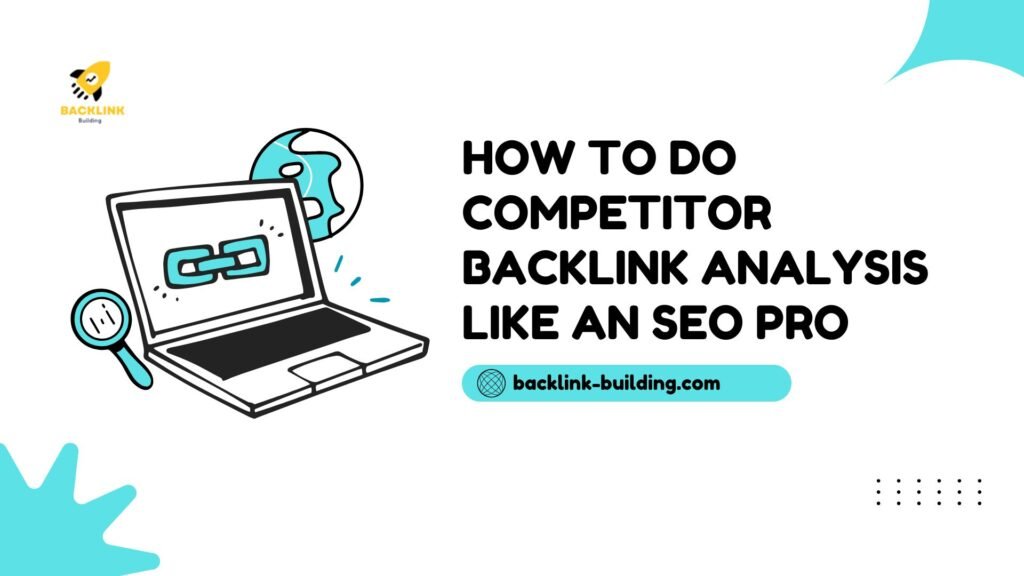
Imagine this. You are trying to grow your website, but you feel like your competitors are always one step ahead. Their pages rank higher. They get more traffic. And somehow, they always seem to be on top.
So, what are they doing that you are not?
Most likely, they have stronger backlinks.
And here is the good news. You can find out exactly where they are getting those backlinks from. That is what competitor backlink analysis is all about.
It helps you:
- Discover new link opportunities
- Understand what is working for others in your niche
- Save time and effort by not starting from scratch
Let us break it all down step by step. No jargon. No complicated stuff. Just simple ideas that work.
What Is a Backlink?
Before we get into the analysis part, let us first understand what a backlink is.
A backlink is just a link from one website to another. That is it.
When someone links to your website from their site, that is a backlink. And search engines see these links as votes of trust.
The more quality backlinks you have, the better your chances of ranking higher in search results.
What Is Competitor Backlink Analysis?
It means looking at the websites that link to your competitors.
You study their backlinks to learn:
- Who is linking to them
- Why they are linking
- What kind of content they link to
- How strong those links are
This gives you a roadmap to follow. If they got those backlinks, maybe you can too.
Why Competitor Backlink Analysis Matters
Competitor backlink analysis is important because it shows you exactly what’s helping your competitors rank higher on Google. If you want to beat them, you need to know what they’re doing right.
Here’s why it really matters:
1. Uncovers Link Opportunities
You can find websites that are linking to your competitors but not to you. If they are linked to them, there’s a good chance they might link to you too—especially if your content is better.
2. Shows What Works in Your Industry
Not all backlinks are created equal. By studying your competitors, you’ll understand which types of content or link-building strategies are working best in your niche.
3. Helps You Stay Competitive
If your competitors are gaining lots of high-quality links and you’re not, they’ll outrank you. Simple as that. Backlink analysis helps you close that gap.
4. Finds Content Ideas That Attract Links
You’ll see what kind of blog posts, tools, or resources are getting the most backlinks. That can spark content ideas for your own site.
5. Reveals Link Gaps
You can spot areas where your site is missing links compared to others. These “link gaps” are opportunities to improve your SEO quickly.
6. Boosts Your SEO Strategy
With this info, you can create a smarter, more targeted link-building plan instead of guessing what might work.
Step-by-Step Guide To Do Competitor Backlink Analysis
Here is a step-by-step guide to do competitor backlink analysis:
Step 1: Choose Your Competitors
First, you need to know who your competitors are.
Ask yourself:
- Who is ranking above you for your main keywords?
- Who is showing up on Google when you search for things related to your business?
Pick 3 to 5 of these websites. Do not pick huge names like Amazon or Wikipedia. Instead, focus on businesses that are similar in size to yours.
You want competitors who are beatable.
Step 2: Use a Backlink Tool
Now that you have your competitor list, it is time to peek into their backlink profiles.
To do this, you will need a backlink tool. Some popular ones are:
- Ahrefs
- Ubersuggest
- SE Ranking
- Moz
- SEMrush
Most of these tools let you type in a website and see all the links pointing to it. If you are on a budget, start with a free version. They work fine for beginners.
Step 3: Analyze the Backlinks
Once you have the backlink list, it is time to study it.
Here is what to look for:
1. Source of the Link
Where is the link coming from? Is it from a blog, a directory, or a news site?
2. Content Type
What kind of page is getting the backlink?
- A blog post
- A product page
- A guide or tutorial
This tells you what kind of content attracts backlinks.
3. Anchor Text
Anchor text is the word or phrase used in the link.
Is it:
- The brand name
- A keyword
- Something generic like “click here”
This helps you understand how natural the links are.
4. Follow or No-follow
A follow link passes SEO value. A no-follow link does not.
You want more follow links, but a healthy mix is totally fine.
Step 4: Filter Out the Junk
Not all backlinks are good. Some are just spammy or low quality.
Avoid links from:
- Sites with no real content
- Forums filled with ads
- Comment sections with shady links
- Non-English or unrelated pages
Focus on backlinks that come from real, helpful content.
Step 5: Spot the Easy Wins
Now comes the fun part.
Go through your competitor backlinks and make a list of the ones you can also get.
Look for links from:
- Guest posts
- Resource pages
- Listicles or roundups
- Business directories
- Niche blogs
These are your easy wins. Reach out and try to get your website listed in the same places.
Step 6: Make a Backlink Plan
Once you have a list of good backlink opportunities, build a plan.
Break it down like this:
- Target Site: Where the backlink is from
- Page to Link: Which page on your site fits best
- Link Type: Guest post, directory, mention, etc.
- Outreach Plan: Email, contact form, or social media
Having a clear plan keeps things organized. You will not waste time guessing what to do next.
Step 7: Start Reaching Out
Time to take action.
Reach out to the website owners or editors. Keep it short and friendly.
Here is a basic email template:
Subject: Quick question about your article
Hi [Name],
I came across your post on [Topic] and really enjoyed it. I noticed you linked to [Competitor Site], and I have a similar piece that might also add value.
Here is the link: [Your Page]
Would love if you gave it a look. Either way, thanks for creating such helpful content!
Cheers,
[Your Name]
Personalize it a bit. Mention something specific from their post. Keep it human.
Step 8: Track Your Progress
Keep a simple spreadsheet. Note:
- Who you contacted
- When you contacted them
- If they replied
- If they gave you a backlink
Follow up if needed. Sometimes people forget. A gentle reminder works.
Step 9: Repeat the Process
Competitor backlink analysis is not a one-time thing.
Do it every few months. Check for:
- New competitors
- New backlinks
- Lost backlinks
This keeps your strategy fresh. And you will always have new ideas for where to get links.
Tips to Make This Process Even Better
Here are a few bonus tips that can take your backlink game to the next level:
1. Focus on Quality Over Quantity
One good link from a popular blog is better than 20 spammy ones.
2. Improve Your Content
If you want people to link to you, your content needs to be great. Simple, helpful, and easy to read.
3. Be Helpful in Communities
Join forums, Reddit, or Facebook groups in your niche. Be active. Share tips. Sometimes, good links come naturally from helpful interactions.
4. Use Broken Link Building
Find broken links on your competitor’s sites and suggest your own as a replacement.
5. Make Shareable Stuff
Create templates, tools, checklists, or infographics. People love linking to things that save time.
Common Mistakes to Avoid
Here are a few things you want to avoid when doing backlink analysis:
- Copying your competitor’s strategy exactly
- Getting links from shady websites
- Ignoring new backlink trends
- Not updating your outreach emails
- Trying to get links too fast
Take your time. Build naturally. Stay consistent.
Real-Life Example
Let us say you run a blog about pet care.
You search your main keyword, “best dog food,” and find 3 competitors. You check their backlinks using a free tool. You notice they get links from:
- Pet owner forums
- Local pet store blogs
- Lists of best pet blogs
- Pet nutritionists
You now know where to focus your efforts. You can:
- Join the same forums and contribute
- Reach out to pet blogs for a guest post
- Create a resource on dog nutrition and pitch it to those who linked to your competitors
This simple process gives you a clear direction.
Conclusion
Competitor backlink analysis does not have to be hard.
You do not need to be an SEO pro to do it. All you need is:
- The right mindset
- Some basic tools
- A little patience
Start small. Pick one competitor. Find five good backlinks. Reach out to one person a day. It adds up.
Backlinks take time, but the results are worth it. Higher rankings. More visitors. And a stronger online presence.
Now you know the secrets. Go ahead and put them into action.
And remember — your competitors are doing this too. Stay one step ahead by learning from them.


